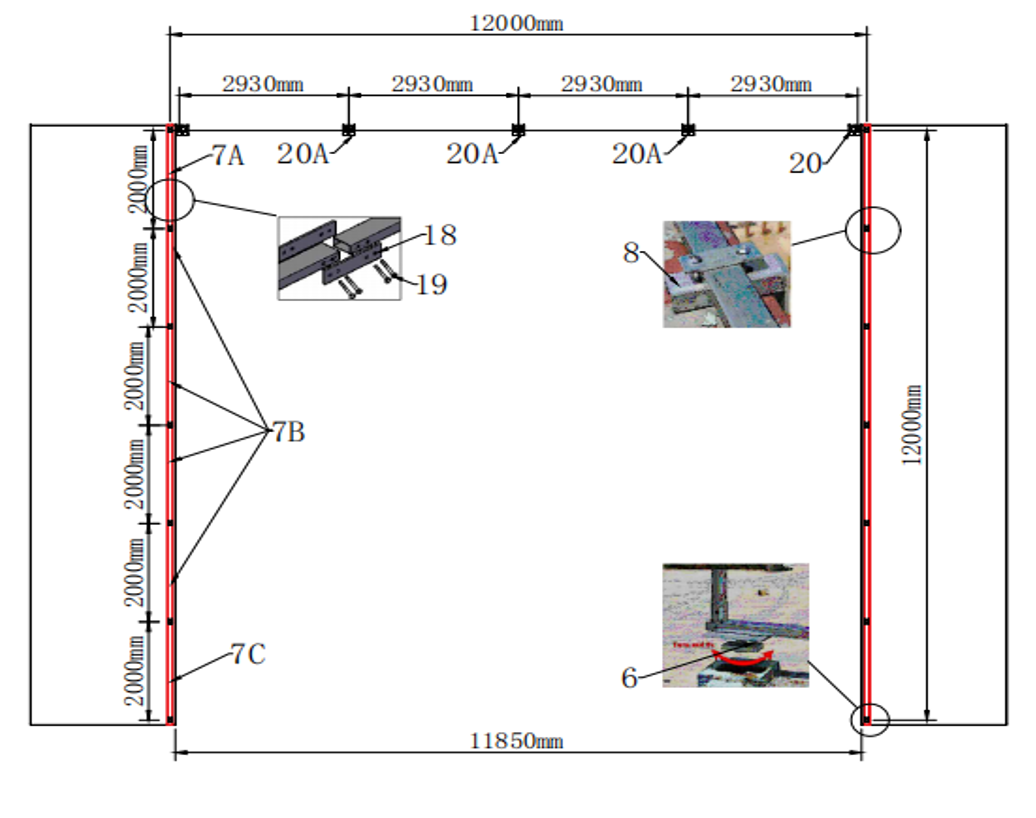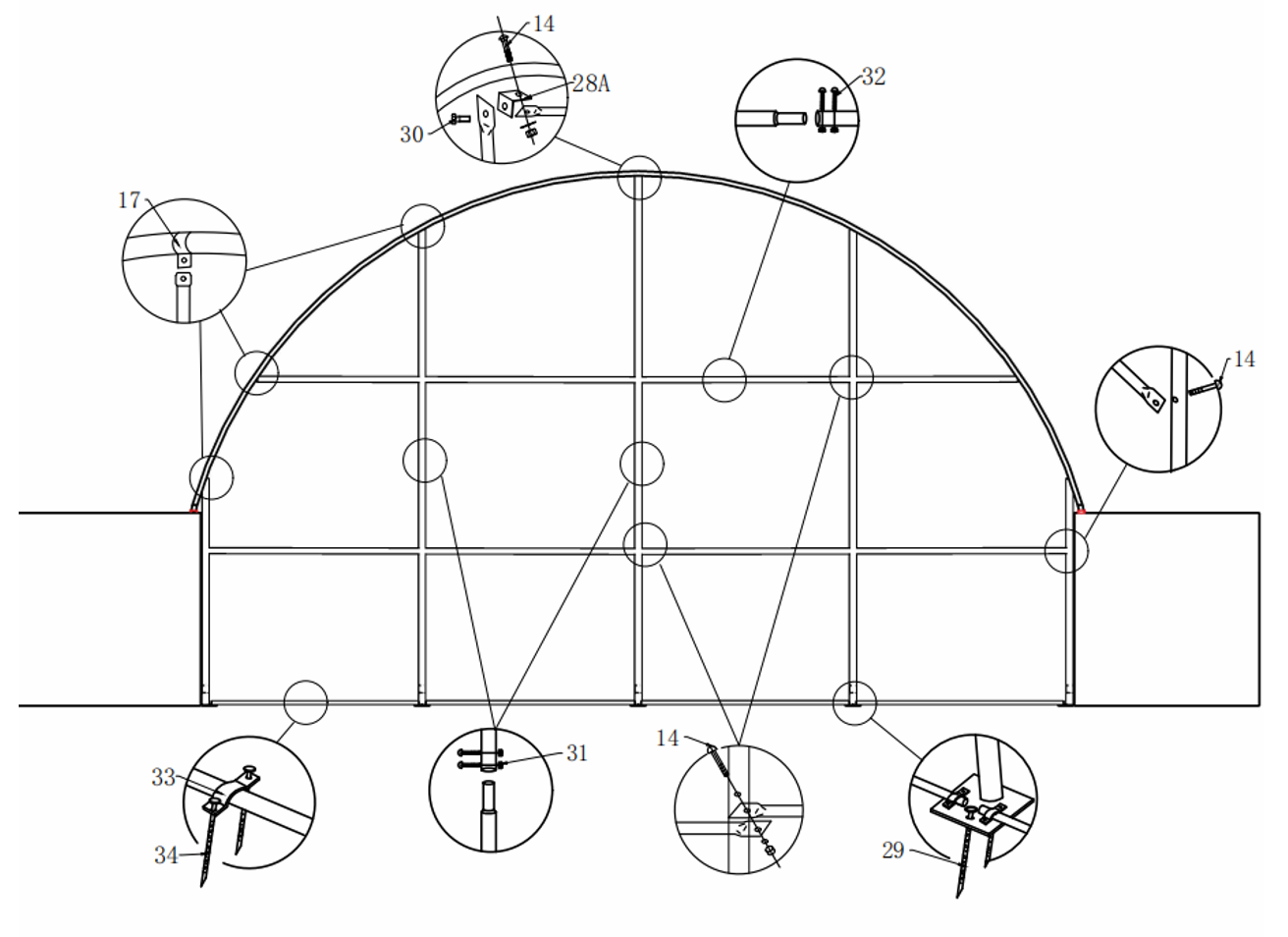Model C4040 QH PREMIUM
Size: W 12 x L 12 x H 3.4 m
Bolted to a shipping container
Maximum wind load is 80 km/h
Maximum snow load is 0.28 kPa

PARTS LIST


IMPORTANT----- READ THE INSTRUCTIONS FIRST
Improper site preparation, installation and maintenance can invalidate the warranty and result in an unnecessary and costly error.
For easy assembly, we have identified each individual component with the part code indicated in the parts list. Familiarise yourself with the part code numbers and drawing to ensure trouble-free assembly.
If road salt or other highly oxidising substances are to be stored under the canopy, it is necessary to store them in sealed big bags or under cover.
READ THE INSTRUCTIONS WITH COMPLETE INTEGRITY BEFORE INSTALLATION, IF YOU HAVE DIFFICULTIES CALL +48608529940 or email: kontakt@inamiot.pl
1. Check the contents of the package after opening the transport box. Make sure all the container shelters are in the crate.
2. Do not set up the container shelters in strong winds, in marshy areas or on unstable ground. Check the weather forecast.
3. Check local regulations and plan the location of the canopy so that the required distance from electrical, gas, water and other cables is maintained.
4. If the canopy is based on shipping containers, these should be level, positioned according to instructions, i.e. parallel, and if they are not fixed to the ground, they should be loaded according to the regulations for the area in which the canopy is to be erected.
5. Pay attention to the direction of the screw. Do not install the bolts on top of the structural frame of the tent where the material will rest, as you will damage the material.
6. Cover all pipe and bolt connections with repair tape (silver tape) to protect the canopy.
7. Work in accordance with health and safety requirements. Take care not to cut your fingers with clamps and tubes during assembly. Assemble with protective gloves, work boots etc.
8. Ensure that containers are accessible from all sides during assembly, so that you can manoeuvre with a forklift, telescopic loader, hoist etc .
9. All operations should be carried out by professionally qualified persons.
10. Keep the work area clean.
11. Do not use sharp tools when in contact with the tarpaulin.
12. If you are installing the curtain in winter, the curtain itself must be stored in a room with a minimum temperature of + 10 C or higher 2 days before installation. must be unfolded at this temperature. Otherwise cracks or fractures may appear in the curtain.
13. The canopy should only be assembled from the components supplied. It is not permitted to modify, alter etc. the elements of the container roof. The elements of the container shelters must not be modified, altered or similar. Any changes to the elements, substitutions of elements will void the guarantee.
14. No additional loads may be attached to the tent structure. The structure is only rated for snow load, wind load and its own weight.
EQUIPMENT AND TOOLS REQUIRED FOR INSTALLATION
1. Measuring tape
2. Repair tape (silver tape)
3. Chalk(marker)
4. Level
5. Screw spanners.
6. Step ladder
7. Welder(container welded version)
8. Hammer
9. Knife, scissors.
INSTALLATION PROCESS
The containers on which the canopy is spread should be fixed to the ground!!! If this is not possible, load the containers so that a gust of wind does not cause them to move, as this will damage the structure of the tent and the tent itself.
ASSEMBLY OF BASE PLATES

Fig.1 Positioning of the ground plates
11. Measurementsare given from the centre to the centre of the tubes. Referring to the diagram above and confirming the location of the base plates. MAKE SURE that the base plates are screwed parallel to each other and at right angles to the opposite base plates. Remember to rotate the base plate component inside the container corner brackets.
22. Then install the elements (7A, 7B, 7C) using (18, 19).



FRAME INSTALLATION

Fig.2 Assembly of the arches.

Fig.3 Assembly of the first arch.

Fig.4 Installation of the purlins.
13. As shown in the picture above, find one curved top arch tube (No.1), two middle arch tubes (No.2), two bottom arch tubes (No.3). Use a screw to join them together to form one group of arches. Note the direction of the screw. DO NOT install the bolts with the wint face up where the fabric will rest.
24. Install the base arch into the base plates.
35. When you have finished installing the first two arches, connect the purlins (no. 4) to them using screws (14). There are 7 pieces of connecting purlins (No. 4) between each arch. Then install the third arch in the base plate and connect the purlins. Finally, install the diagonal stiffening tube (no. 12) using the square clamp (no. 17). Assemble the entire frame in this way.
6.
Secure all pipe and bolt connections with repair tape (silver tape).

Fig. 5 Securing the arch joints with repair tape
INSTRUCTIONS FOR ASSEMBLING THE BACK WALL

Fig. 6 Construction of the back wall.

Fig. 7 Rear wall pipe connections

Fig. 8 Assembly of tarpaulin
ROOF TARPAULIN INSTALLATION INSTRUCTIONS
Important: DO NOT install the canopy in high wind conditions.
1. First lay the tarpaulin (part code 11) on the roof of one of the containers and secure it to the container. Lay the tarpaulin EQUALLY, CAREFULLY and SLOWLY on the frame. Check the fabric to make sure it is evenly distributed.
2. Use ropes to staple the tarp to the two side bows, finally tie the tarp to the mounting plate and tubes (#5).
3.Then cut the fabric of the tarpaulin over the pipe to the width of the transport straps in the pocket of the tensioning tube at the transport strap tensioners (No. 9) Then drape the transport strap around the pipe tensioning the tarpaulin as in figure 3. Evenly tension the transport straps so that the tarpaulin sits evenly on the roof structure. Finally install the plug (part code 16) on the lower tension tubes. Finally, tie the roof covering and tension tubes together using rope, as shown in the figure above.

Fig. 9 Tensioning the tarpaulin

Fig. 10 Tensioning the tarpaulin
NOTE: DO NOT LEAVE THE ROOF COVERING UNTIGHTENED IN ANY Circumstances until final assembly and tightening is complete.
The process is fairly easy. But some tightening adjustments will be necessary to achieve a flat, taut roof covering. Please inspect the roof covering at least once a month.
Operation guide.
1. When using, make sure there is adequate ventilation for fumes and other hazardous fumes .
2. Be aware of energy and heat sources. Do not keep heat sources near the tarp. Do not expose to open flames.
3. Heating appliances and other heat sources, must be min. 2 m from the canopy.
4. Remove the cover during a hurricane.
5. Check the fixing of containers to the ground. Containers on which the canopy is spread should be fixed to the ground. If this is not possible, load the containers so that a gust of wind does not cause them to move, as this will damage the tent and marquee structure. Check the anchoring of the containers at least once a month and after every strong wind > 50 km/h.
6. It is necessary to stretch the roof fabric using the carrying straps provided, tight enough to avoid "hammocks" on the roof. During use, the fabric should be re-tensioned once or twice after several months of use. This is especially important when installing the canopy in cold weather (autumn and winter), as the fabric is then stiff. When we have sunshine and warm weather, lays better on the structure and the fabric can get "loose", in which case the fabric should be tightened again.
7. It is the owner's responsibility to remove the snow immediately if it does not slide off on its own.
8. Carrying strapsand other rubber parts are subject to wear. Their condition should be checked once a month and replaced as necessary.
9. To clean the tarpaulins of container shelters, a gentle drenching with water and cleaning fluid that does not damage the PVC is recommended. Karcher-type washing equipment can be used at low pressure and from a safe distance.
10. If dismantling, use a packing list. Do not pack a wet canopy.
